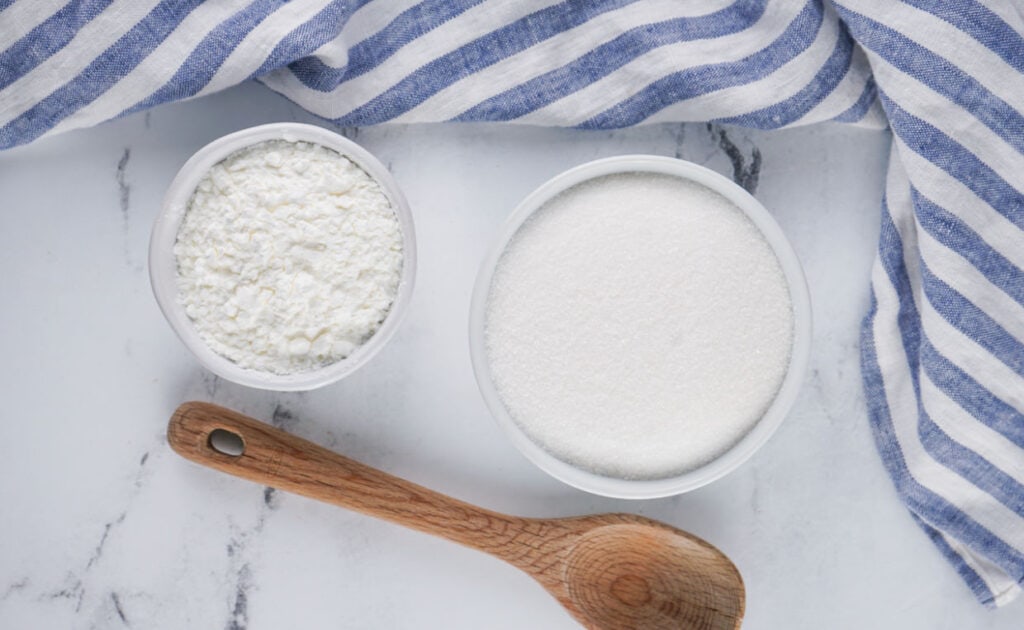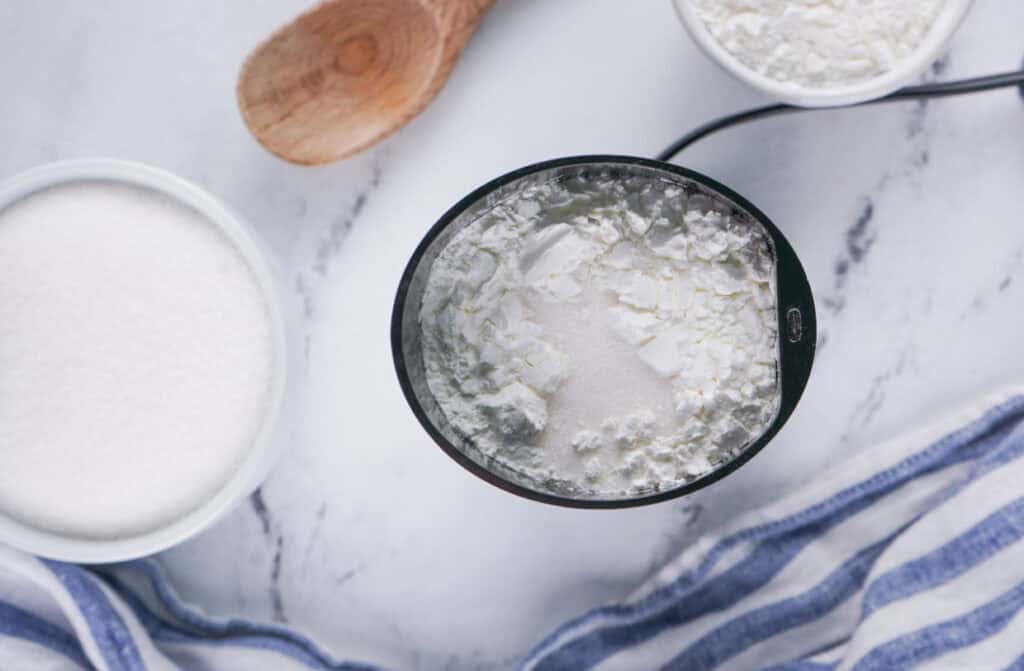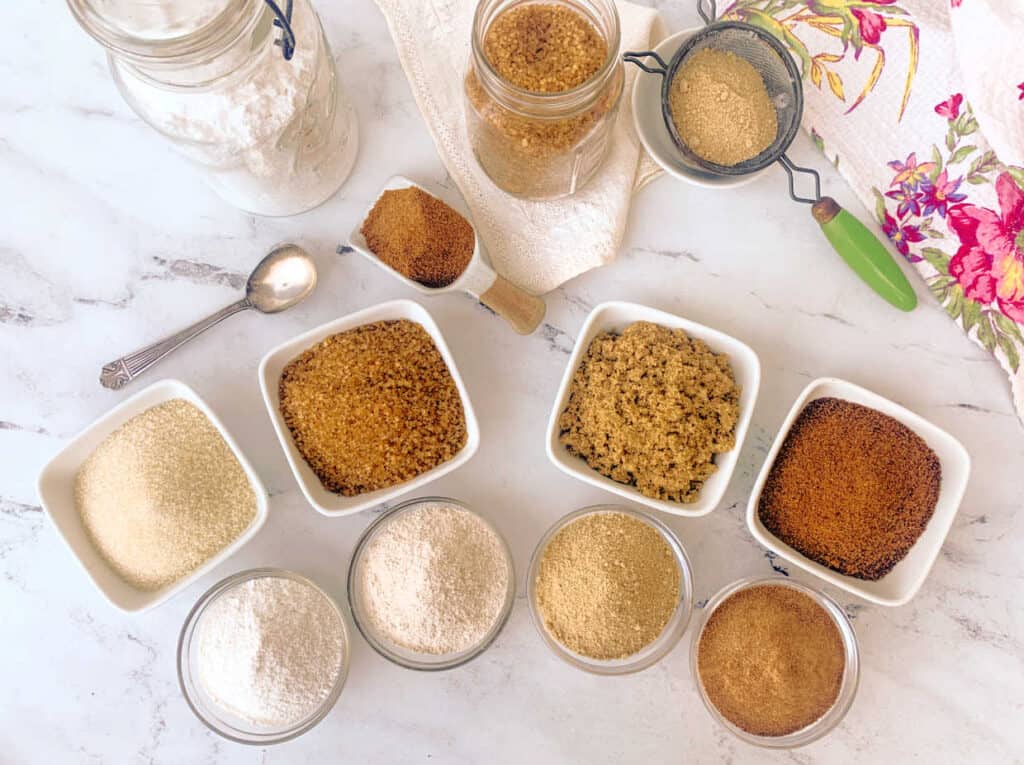In those moments when a recipe calls for powdered sugar and you find your pantry lacking, fear not. With just a few simple ingredients and less than 5 minutes, you can make homemade powdered sugar right in your kitchen.

Say goodbye to last-minute grocery runs and hello to homemade goodness. In this guide, I’ll walk you through the easy steps to create your own powdered sugar so you’ll never run out again. Plus, I’ll share tips on customizing it to your taste preferences.
The basics of powdered sugar
Powdered sugar, also called confectioners’ sugar or icing sugar, is granulated sugar that has been finely ground and often contains a small amount of an anti-caking ingredient, like cornstarch, to prevent clumping and keep it dry. This fine texture makes it ideal for recipes that require a smooth consistency, such as icings and buttercreams, and it’s used to sprinkle on top of desserts.
Ingredients to make powdered sugar
You might be surprised to find this ingredient list small. Making powdered sugar at home requires just two basic ingredients.
- 2 cups granulated sugar: Forget fancy ingredients. Powdered sugar is simply granulated sugar that’s been ground down to a super fine texture. This means the main ingredient you’ll need is granulated sugar itself.
- 2 tablespoons cornstarch: While cornstarch is optional for immediate use in no-bake recipes like frosting, adding a small amount helps prevent clumping and extends the shelf life of your homemade powdered sugar by absorbing moisture and keeping it light and airy. You should add it if you’re using powdered sugar for baked goods like cookies and cakes.

Equipment needed
Although a high-ender blender such as a Vitamix, Nutri Bullet or food processor is perfect for making powdered sugar at home, a coffee grinder or a Magic Bullet can also be used for smaller batches. Experiment to find the appliance that works best for you.
How to make powdered sugar
When finished, you should have roughly doubled the amount of powdered sugar compared to the initial amount of granulated sugar. This means that if you start with 2 cups of granulated sugar, you will end up with about 3 and three-quarters cups of powdered sugar.
- Add the granulated sugar — and cornstarch, if using — to your chosen appliance.
- Blend for 30 to 60 seconds using a high-end blender or 4 minutes using a food processor until the sugar is very fine and fluffy.
- Stop and stir the sugar to ensure it’s been thoroughly blended. If it feels gritty when rubbed between your fingertips, continue blending.
- Powdered sugar made at home can be stored indefinitely. Keep it in a sealed container in a cool, dry place to maintain its freshness. If you plan on storing it for a while, remember to include cornstarch to prevent clumping.

More powdered sugar options
White powdered sugar is widely available in stores, but for a different option, consider using unrefined sugars. Unrefined sugar will result in a grainier texture and a caramel-like flavor. Experiment with these sugar varieties to add a unique twist to your baked goods and desserts.

- Cane sugar is similar in flavor to granulated sugar but slightly darker in color and has larger grains.
- Brown sugar is granulated sugar mixed with molasses and has a high moisture content. When making powdered brown sugar, use cornstarch.
- Turbinado sugar contains some natural molasses, giving it a light brown color and a caramel flavor. It also has larger crystals than brown sugar.
- Coconut sugar is tan in color and has a rich caramel flavor. It comes from the sap of the coconut palm tree.
Creative uses for homemade powdered sugar
In baking, powdered sugar lends a silky texture to treats like cookies, fudge, meringues and more, enhancing their delectable quality. A crinkle cookie would not be the same without it being covered in powdered sugar.
Powdered sugar dissolves easily in drinks like hot chocolate, coffee, cocktails and more. Sprinkle powdered sugar into your cold foam for a little sweetness in your coffee.
Make a quick glaze for cakes, cookies and scones with powdered sugar. You can also sift powdered sugar over cakes, beignets, brownies, rosettes or lemon bars to add sweetness and make your desserts look pretty.
Making powdered sugar at home can be a cost-effective option, especially if you frequently use it in your recipes. The satisfaction of creating a staple ingredient from scratch and knowing what goes into it exactly adds an extra layer of control to what you put into your dishes.
“It’s so simple to make your own powdered sugar — just throw some white sugar in a blender, and you have powdered sugar to sprinkle on desserts without paying a ton for it.”
— Shruthi Baskaran-Makanju, Urban Farmie
Once you learn how to make homemade powdered sugar, you can say goodbye to store-bought. Whether you make your own with granulated sugar or customize it with different unrefined sugars, you will have an essential ingredient to suit your taste.
Jere Cassidy is the writer and recipe developer behind the blog One Hot Oven. A passion for all things food-related led her to culinary school to expand her baking skills and now to share easy recipes for all home cooks and bakers of all skill levels. When not in the kitchen, Jere’ likes to travel far and wide to find delicious food.